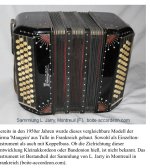You guys are all just great in my book regardless of whether you want to keep or drop Stradella. Indeed, the accordion is many things to many people. Now, I am fully aware that I am in the company of very gifted individuals here, who are much smarter than me, but for what it's worth (and I'm certainly not Nostradellus

), here's what I think...
Having spent time playing two types of converter accordion; a Quint converter and a Chromatic converter, I think it is only Quint converter that is truly at home in a converter instrument because it is a by-product of Stradella bass. We must realise Quint was not 'designed', it just occurred when the inventor of this converter mechanism released the notes from the prefixed chords.
I will explain briefly:
Take one section of Stradella bass buttons along the C rows:
Row 1: E (Counter bass)
Row 2: C (Fundamental bass)
Row 3: C major
Row 4: C minor
Row 5: C 7th
Row 6: C dim.
When this was converted by pressing the switch to Quint free bass, air was simply routed to certain notes that exist in the chords already:
Row 1: E (counter bass) unchanged from BASS octave
Row 2: C (fundamental bass) unchanged from BASS octave
Row 3: E (taken from C major chord) unchanged from TENOR octave
Row 4: C (taken from C minor chord) unchanged from TENOR octave
Row 5: E (taken from C 7th chord) unchanged from ALTO octave
Row 6: C (taken from C dim chord) unchanged from ALTO octave.
Good, bad or indifferent this is the only "natural" converter bass system ever created and that is how the basic 3 octaves of Quint emerge, when the converter is applied across the range of a 120 bass accordion.
By contrast the chromatic converter design was based on the right hand keyboard layout of the button accordion. The chromatic sequences would never occur in the stradella chords layout naturally. The converter adds 'new notes'. It took A LOT of engineering to make the mechanism work well in a converter system and I understand they are still at times prone to jamming.
The chromatic free bass is not at it's best constrained within a converter mechanism. It had to be reduced to 4 rows as the Stradella single notes own rows 1 and 2. Also, the thumb which is extensively used on the RH of the button accordion is only awkwardly but frequently used on row 1 on a chromatic converter (unless there are steps added).
I think chromatic free bass would be much better employed on a free bass only accordion and would more truly mirror the RH that way. The LH is a shadow of the RH within the constraints of a chromatic converter. Converter systems are not perfect and never were, that's why Mr Moschino and many others tried to create better free bass only alternatives over the years...
For me, I'll stick to the converter accordion and am perfectly happy with both Quint and Chromatic versions. Stradella and many converter systems will certainly continue as they are overwhelmingly popular, but on balance the chromatic version should be properly freed from a converter in the long term.




